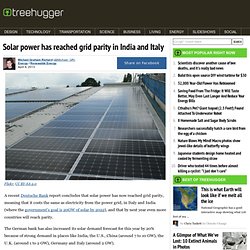

Residential Solar Power Heads Toward Grid Parity. Photovoltaics are still, on average, a pricey, subsidy-dependent source of electricity.

However, rooftop panels are beginning to beat the grid in a number of jurisdictions with high retail power rates—and their ranks are projected to swell over this decade. A growing number of economists say that rapidly shrinking costs have turned distributed solar generation into a disruptive technology that’s set for runaway growth. In fact, they say, it could ultimately upend the power distribution market. “We’re completely unprepared for the opportunity that’s going to present itself,” says John Farrell, an economist and senior researcher at the Institute for Local Self-Reliance, a Minneapolis-based economic think tank.
Farrell got beyond the less-inspiring U.S. national average price of rooftop solar on homes and businesses by examining how it stacks up in each of 3100 electric utility rate zones across the country. The Three Best Things Minnesota Did For Solar Energy In The Last Week. Last week, Governor Mark Dayton signed an economic development bill that contained several powerful incentives for solar development.

This confirms what many have been saying for quite some time — that solar is careening toward widespread adoption and will create jobs while reducing emissions along the way. This development is a good indicator of some fundamental dynamics that are playing out in the energy space. First, if you were to look at a map of US solar potential, Minnesota would not be the first place you’d put solar panels. This can also be said of Germany — not exactly heralded for its sunny weather — but which still has 1.3 million installed solar power systems that just set a new peak output record of 22.68 GW. So why is solar getting traction in these places?
Well, with the cost of solar PV dropping 80 percent since 2008 alone; the truth is that economic inertia has made solar practical even in places like Minnesota and Germany. TreeHugger. Flickr/CC BY-SA 2.0 A recent Deutsche Bank report concludes that solar power has now reached grid parity, meaning that it costs the same as electricity from the power grid, in Italy and India (where the government's goal is 20GW of solar by 2022), and that by next year even more countries will reach parity.

The German bank has also increased its solar demand forecast for this year by 20% because of strong demand in places like India, the U.S., China (around 7 to 10 GW), the U.K. (around 1 to 2 GW), Germany and Italy (around 2 GW). We've already written about how China is expected to become the world's biggest solar market this year (it already is the biggest producer).
There's also progress with big concentrating solar farms, even though the big drop in solar PV prices has made them relatively less attractive than they used to be: The current biggest CSP plant has started operations in the UAE, and an even bigger solar CSP farm is under construction in the Mojave desert in the US. Analysis: Renewables turn utilities into dinosaurs of the energy world. Home / GRID Alternatives. Solar Power - Clean Energy Authority.